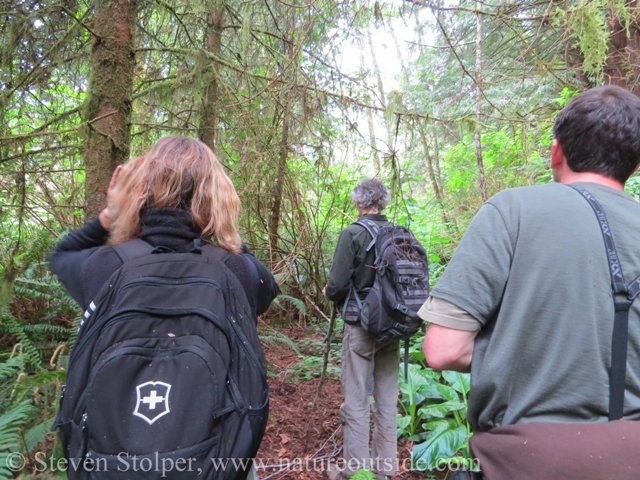
Did I really want to see a bear? I thought it over. On one hand, how exciting would it be to get close to such a powerful wild creature! On the other, an animal that size can do some real damage…
I assumed the debate was moot. There were seven of us in the bear tracking class. Although we tried to move silently as we crept through the forest, we couldn’t help snapping twigs and moving foliage. Certainly no self-respecting bear would be caught by surprise.
In part 3, we may have come very close to meeting a bear. But it snuck away as we approached and we lost its tracks in the swamp. Today was going to be different.
But First, the Dead Bodies
Have you ever hiked along a trail and found a dead rodent? Bending to examine the body, you can’t find a mark on it. What happened? How did it die?
This experience happens often enough that I wonder about it. Something is going on that I don’t understand. I find mice, moles, voles, and shrews. All as dead as dialup internet.
As our group hikes along a well used trail we find a shrew and later two dead moles near each other.
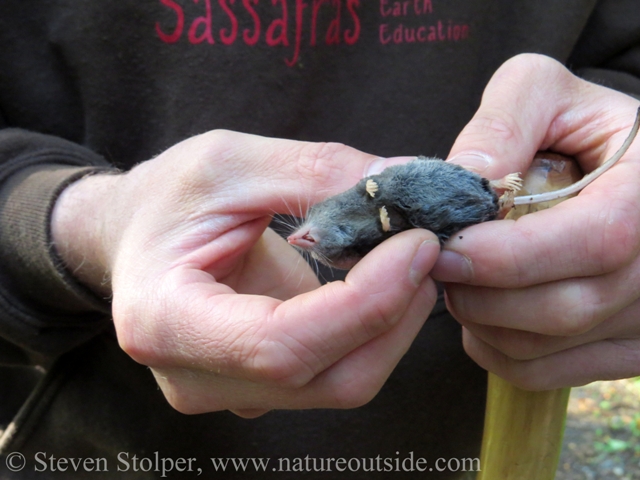
A dead shrew, with not a mark on it
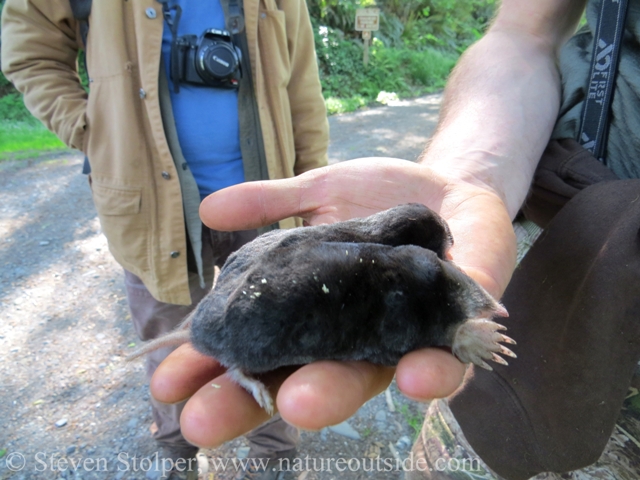
Two dead moles found along the trail within 20 feet of each other. I photographed from the side, not the rear, because this isn’t a post about molasses.
Preston, one of our teachers, said a fox had killed them. He mentioned that foxes sometimes kill small animals and leave them dead and unconsumed. But he did not go into detail. Was this surplus killing? Was it learning or practice? Or was it simply instinct? I plan to learn more about this if I can. So if you have any information about this phenomena, please leave a comment for me below.
Bringing Tracking to Bear
We started early in the morning near the Klamath River. Mist shrouded the surrounding hills creating an eerie stillness.
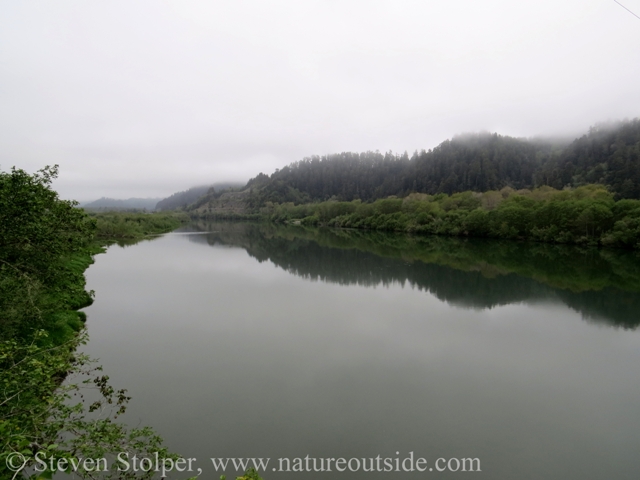
The Klamath River flows 263 miles through Oregon and northern California
The air was chilly and damp. I shifted my weight from foot to foot in an effort to keep warm.
Our trail climbed the face of a heavily forested hillside. Below us was another swamp. The edges were overgrown with reeds and Lilly pads that concealed the water’s surface. I watched a snowy egret stalking the shoreline. Its plumage glowed white, ghostlike, against the deep green reeds. The egret raised and lowered its yellow feet as it disappeared from my view.
Our plan was the same as Part 2. We ascend the trail looking for signs of bear. When we pick up tracks crossing the trail, we follow them in the hopes of locating the bear.
Almost on cue, we detected a nice set of bear tracks heading downward toward the swamp. We knew from the day before that it was likely heading toward a place to feed.
It was a treacherous descent down the hillside. The wet forest duff was slippery as ice. I marveled at the bear’s dexterity as I grasped at redwood branches and roots to keep my footing.
Skirting several enormous trees, I was the fourth person to reach the bottom. We found ourselves in a kind of dead ground. It was a strip of land running parallel to the bank of the swamp. A large berm screened us from the water. The small trees and reeds growing on it created a de facto blind. We could catch glimpses across the water while remaining concealed against the dark foliage of the hillside.
Bear!
We waited silently for the others to join us at the bottom of the hillside. Suddenly, we heard a thunderous crash of foliage! It was just ahead of us on the other side of the berm. There was a quick succession of heavy impacts with the ground, and silence. We froze.
If you hike often, you have probably flushed deer. You don’t even need to see them to know what they are. Their characteristic footfalls telegraph their identity as they bound away. But this was something else entirely! It was heavy and it moved in a way I had not heard before. The pattern was new. It had to be a bear!
Preston motioned us down, gesturing that it was indeed a bear. He used hand signals to communicate with Matt, our other guide still descending the hillside. Matt froze along with the rest of the students above us. He hand-signaled back that he could not see the animal.
Preston signaled for us to remain motionless as he went ahead to explore. We listened intently to try to hear more movement. But the swamp betrayed nothing. Several of us used a technique called “Deer Ears” to try to locate the bear. You cup your hands and place them behind your ears with your thumbs pointing skyward. Your cupped hands act as sound reflectors and increase the gathering capacity of your ears. The gain is directional and we pivoted slightly to sweep the area.
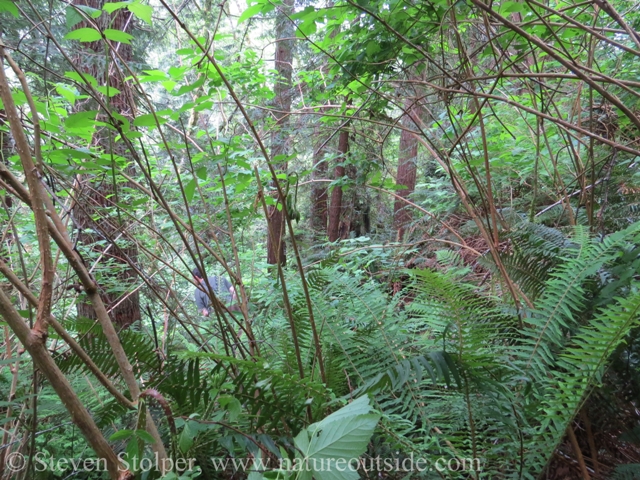
Preston scouts ahead, looking to see if the bear is still lurking

Listening with “Deer Ears.” This technique uses cupped hands to gather more sound.
Nothing, not a sound. Was the bear still lurking or had it crept off?
We gathered to discuss our next move. Preston thought we “pushed” the bear. He thought the bear had probably fled. But he suspected it would double back to discover what had frightened it. It turns out that bears are curious creatures, even when frightened.
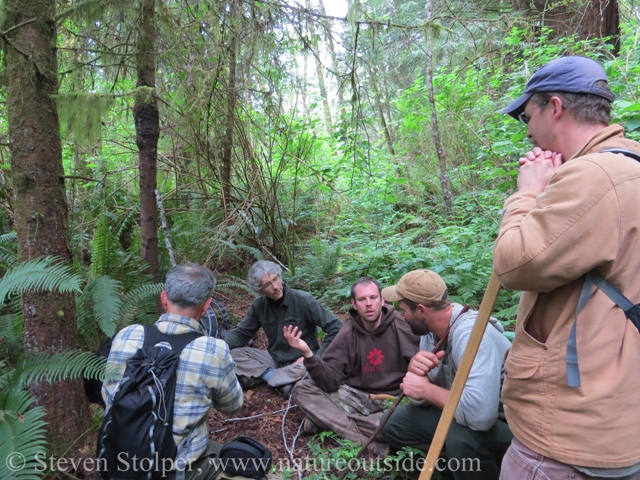
We huddle to plan our next move. The berm is to the left and runs into the distance.
We decided to follow the tracks. But it was very important to move silently. If the bear heard our voices or recognized us as human, it would take off like a shot.
In Hot Prusuit
The next two hours were intense. And I apologize for the lack of pictures. Bears will move through dense brush if they think they are being pursued. Often they negotiate densely packed branches, intending that whatever is chasing them will signal its approach with the waving of leaves.
I assumed I had the advantage in this terrain. I was short and slender, more so than my fellow trackers and much more so than the bear. But I didn’t count on my backpack and camera equipment. My pack snagged on the branches above. And my camera, attached to my belt, prevented me from crawling on my stomach. I quickly transferred my camera into my pack and grabbed work gloves to fend off the salmonberry thorns that snagged my shirt.
We crawled on hands and knees to get under branches and bushes. And we stepped over and through densely woven branches in a slow motion caricature of the Joffrey Ballet. All of this was done in silence. Everyone wanted to see the bear, the feeling was palpable.
Who’s Tracking Who?
We stopped for lunch right on the bear’s trail. I used my Fallkniven F1 knife to cut the lowest hanging branches to give enough room to stand, albeit hunched over. With the added light filtering through the foliage it was a cozy lunch spot in the understory.
We almost lost the trail when the bear turned suddenly 90–degrees. I could see what the bear was doing. Frightened by our approach, it fled away from us along the bank of the swamp. Finding a convenient exit, it turned uphill to leave the area. It was time to climb the steep hillside, away from the swamp.
My quadriceps protested as we climbed. But we did not have to go far. Suddenly the trail veered again. I could tell immediately that the bear had doubled back. It was creeping back along the hillside, to look down at its pursuers.
We worked our way back across the hillside. I could not believe it! But the evidence was right before our eyes. The bear had stopped and descended the hill about ten feet to break out of the dense vegetation. Now, standing in its tracks I looked down at the very spot where I had been crawling on my hands and knees just an hour and a half ago! Had it seen us crawling in a line through the underbrush? Or had it just gathered our scent from above? Either way, the disturbance on the ground told what happened next. The bear reversed itself and bounded like a shot up the hill. It knew what we were and wanted no part of us!
Pushing the Bear
We followed the bear uphill. But I don’t want to give the impression that trailing an animal is easy. We were constantly losing its trail and finding it again. But that was the point of the class. It was a chance to experience trailing an animal and honing our patience, concentration, attention to detail, and powers of observation.
As we climbed, we found evidence we were gaining on the bear. Remember that an animal will flee for its “flight distance.” And when it feels comfortable, it will return to its normal behavior. We found fresh feeding sign and scat so new, I looked around for the bear itself.
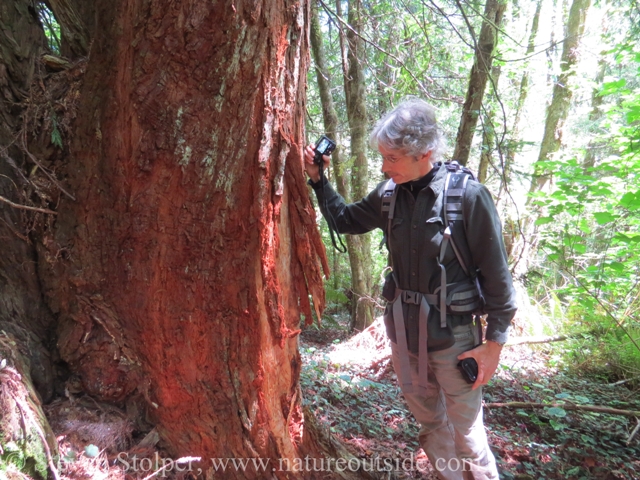
The bear’s trail passed by signs of recent feeding
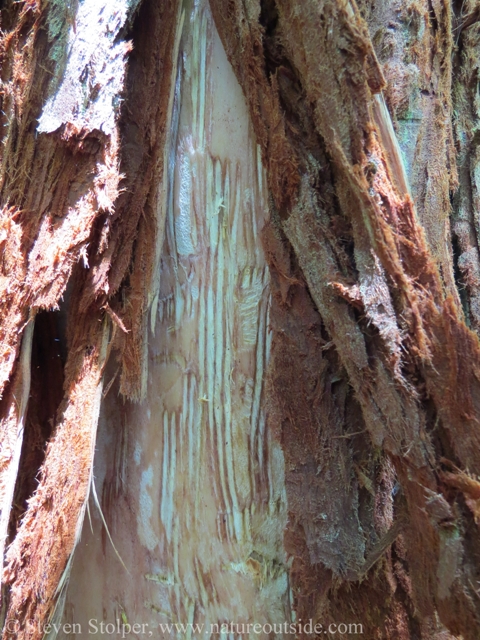
The bear’s canine teeth cut the parallel grooves
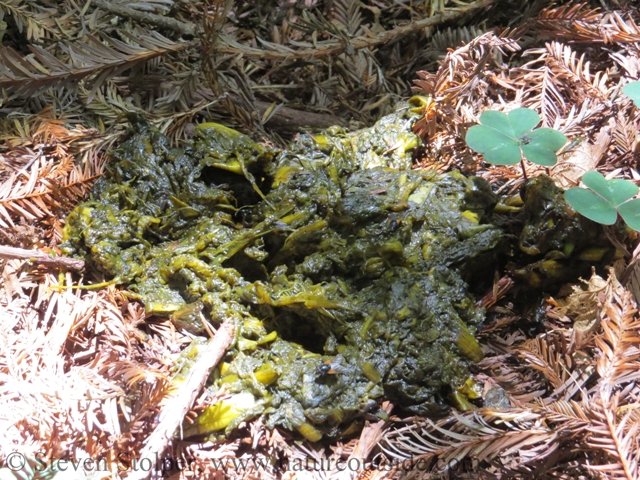
This scat is so fresh that the skunk cabbage is still green
Not long after finding the scat, the bear’s trail began to meander across the face of the hillside. We were back in dense forest and visibility was limited. We suspected we were catching up to the animal.
Our suspicions were confirmed by a loud, crack! It was the sound of a tree branch snapping. From up ahead we could hear several other tree branches being snapped. Preston and Matt stopped us with a whisper. They had stationed themselves immediately behind the lead trackers and now they moved to the front of the group. We waited in silence.
After a few minutes we huddled up. Preston explained that the bear was just ahead. The sounds we heard were an aggressive warning. We had already “pushed” the bear this morning and now here we were again. This was the limit of the animal’s tolerance and the broken branches were a warning not to approach. It was time for us to go.
Flushed with success, we turned back toward the trailhead.
Trailing for the Nature Lover
I enjoyed the class and learned a number of valuable techniques. These techniques can help anyone who loves nature learn about and locate animals.
Just the experience of finding tracks and trying to follow them was invaluable. Under our guides’ watchful eyes we practiced the concentration, dedication, patience, and effort required to follow a wild animal through its habitat.
Seeing bear sign and learning about their behavior is also valuable for anyone who visits bear country. Do you know the phenomena when you’re driving a new car and suddenly realize every third car is the same as yours? Where were they hiding before you got your car? Of course they were always there. But your increased sensitivity now causes you to notice them. I hope the same thing will happen the next time I backpack in the Sierras. I would love to see bear sign and be able to learn about the bears from the tracks they leave.
Stalking the Black Bear – High Adventure in the Forest (Part 1)
Stalking the Black Bear – High Adventure in the Forest (Part 2)
Stalking the Black Bear – High Adventure in the Forest (Part 3)
If you enjoyed this article, you may like others in the Tracking Section.


Harassing an animal in the name of “trailing”…pathetic
Wilson, you have a valid concern. But when you trail an animal, it should not even know you are following it. Wildlife conservationists, park rangers, and scientists use this skill to the benefit of nature.
In this case, our “beginner level” class did catch up to the bear. But I suspect this is because the students were such amazing trackers.
Like you, I am concerned about wildlife. The class was taught infrequently. The odds of actually catching up to the bear were low. And this skill is important for trackers to learn. We behaved well when we caught up to the bear. So I am comfortable that this does not fall into the category of “harassment.”
Thanks for sharing all this! I’ve taken an elk trailing course with Preston, and been to a track & sign eval with Matt – really appreciate all the bear specific tips, photos, stories you’ve shared here as I’m finding bear sign and trails and curious to know all i can to both feed my curiosity and keep myself somewhat safe in bear country! And I agree, and spoke with Preston about this question of harassment – trailing practice when food is readily available and animals are healthy, I do not see as harassment. It is many things – participating in the natural world in a highly aware way, learning deeply about an animal & the ecosystem, learning not to simply fear and avoid wildlife, but to respect their skills and develop our own skills in moving through the natural world…
Erica, thank you for your thoughts! You do a great job of describing why we might choose to trail an animal and how, if we are considerate, we are not going to disturb them.